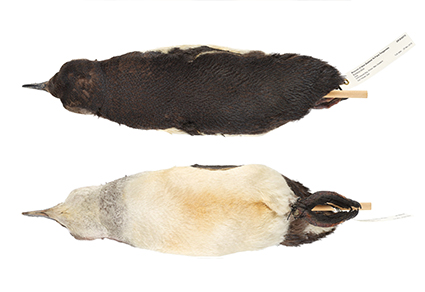Peter Kovalik
Well-known member

Cole, T.L., C. Zhou, M. Fang, H. Pan, D.T. Ksepka, S.R. Fiddaman, C.A. Emerling, D.B. Thomas, X. Bi, Q. Fang, M.R. Ellegaard, S. Feng, A.L. Smith, T.A. Heath, A.J.D. Tennyson, P. García Borboroglu, J.R. Wood, P.W. Hadden, S. Grosser, C.-A. Bost, Y. Cherel, T. Mattern, T. Hart, M.-H.S. Sinding, L.D. Shepherd, R.A. Phillips, P. Quillfeldt, J.F. Masello, J.L. Bouzat, P.G. Ryan, D.R. Thompson, U. Ellenberg, P. Dann, G. Miller, P.D. Boersma, R. Zhao, M.T.P. Gilbert, H. Yang, D.-X. Zhang, and G. Zhang. 2022. Genomic insights into the secondary aquatic transition of penguins. Nature Communications 13: 3912. published 19 July 2022. Genomic insights into the secondary aquatic transition of penguins - Nature Communications
Abstract
Penguins lost the ability to fly more than 60 million years ago, subsequently evolving a hyper-specialized marine body plan. Within the framework of a genome-scale, fossil-inclusive phylogeny, we identify key geological events that shaped penguin diversification and genomic signatures consistent with widespread refugia/recolonization during major climate oscillations. We further identify a suite of genes potentially underpinning adaptations related to thermoregulation, oxygenation, diving, vision, diet, immunity and body size, which might have facilitated their remarkable secondary transition to an aquatic ecology. Our analyses indicate that penguins and their sister group (Procellariiformes) have the lowest evolutionary rates yet detected in birds. Together, these findings help improve our understanding of how penguins have transitioned to the marine environment, successfully colonizing some of the most extreme environments on Earth.
Abstract
Penguins lost the ability to fly more than 60 million years ago, subsequently evolving a hyper-specialized marine body plan. Within the framework of a genome-scale, fossil-inclusive phylogeny, we identify key geological events that shaped penguin diversification and genomic signatures consistent with widespread refugia/recolonization during major climate oscillations. We further identify a suite of genes potentially underpinning adaptations related to thermoregulation, oxygenation, diving, vision, diet, immunity and body size, which might have facilitated their remarkable secondary transition to an aquatic ecology. Our analyses indicate that penguins and their sister group (Procellariiformes) have the lowest evolutionary rates yet detected in birds. Together, these findings help improve our understanding of how penguins have transitioned to the marine environment, successfully colonizing some of the most extreme environments on Earth.





